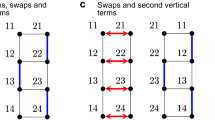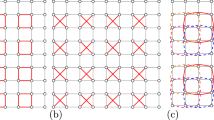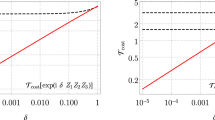Abstract
Solving the Fermi–Hubbard model is a central task in the study of strongly correlated materials. Digital quantum computers can, in principle, be suitable for this purpose, but have so far been limited to quasi-one-dimensional models. This is because of exponential overheads caused by the interplay of noise and the non-locality of the mapping between fermions and qubits. Here we use a trapped-ion quantum computer to experimentally demonstrate that a recently developed local encoding can overcome this problem. In particular, we show that suitable reordering of terms and application of circuit identities—a scheme called corner hopping—substantially reduces the cost of simulating fermionic hopping. This enables the efficient preparation of the ground state of a 6 × 6 spinless Fermi–Hubbard model encoded in 48 physical qubits. We also develop two error mitigation schemes for systems with conserved quantities, based on local postselection and on extrapolation of local observables, respectively. Our results suggest that Fermi–Hubbard models beyond classical simulability can be addressed by digital quantum computers without large increases in gate fidelity.
This is a preview of subscription content, access via your institution
Access options
Access Nature and 54 other Nature Portfolio journals
Get Nature+, our best-value online-access subscription
$32.99 / 30 days
cancel any time
Subscribe to this journal
Receive 12 print issues and online access
$259.00 per year
only $21.58 per issue
Buy this article
- Purchase on SpringerLink
- Instant access to full article PDF
Prices may be subject to local taxes which are calculated during checkout






Similar content being viewed by others
Data availability
The numerical data that support the findings of this study, including a full list of shots, are available via Zenodo at https://doi.org/10.5281/zenodo.13624900 (ref. 47). Source data are provided with this paper.
References
Arovas, D. P., Berg, E., Kivelson, S. A. & Raghu, S. The Hubbard model. Annu. Rev. Condens. Matter Phys. 13, 239 (2022).
Qin, M., Schäfer, T., Andergassen, S., Corboz, P. & Gull, E. The Hubbard model: a computational perspective. Annu. Rev. Condens. Matter Phys. 13, 275–302 (2022).
Wilson, J. A., Di Salvo, F. J. & Mahajan, S. Charge-density waves in metallic, layered, transition-metal dichalcogenides. Phys. Rev. Lett. 32, 882 (1974).
Bednorz, J. G. & Müller, K. A. Possible highTc superconductivity in the BaLaCuO system. Zeitschrift für Physik B 64, 189–193 (1986).
Takada, K. et al. Superconductivity in two-dimensional CoO2 layers. Nature 422, 53–55 (2003).
Catalano, S. et al. Rare-earth nickelates RNiO3: thin films and heterostructures. Rep. Prog. Phys. 81, 046501 (2018).
Wu, F., Lovorn, T., Tutuc, E. & MacDonald, A. Hubbard model physics in transition metal dichalcogenide Moire bands. Phys. Rev. Lett. 121, 026402 (2018).
Ponsioen, B., Chung, S. S. & Corboz, P. Period 4 stripe in the extended two-dimensional Hubbard model. Phys. Rev. B 100, 195141 (2019).
Xu, H. et al. Coexistence of superconductivity with partially filled stripes in the Hubbard model. Science https://doi.org/10.1126/science.adh7691 (2024).
Ray, S. & Werner, P. Photoinduced ferromagnetic and superconducting orders in multiorbital Hubbard models. Phys. Rev. B 110, L041109 (2024).
Zhang, Y., Mondaini, R. & Scalettar, R. T. Photoinduced enhancement of superconductivity in the plaquette Hubbard model. Phys. Rev. B 107, 064309 (2023).
Kaneko, T., Shirakawa, T., Sorella, S. & Yunoki, S. Photoinduced eta-pairing in the Hubbard model. Phys. Rev. Lett. 122, 077002 (2019).
White, I. G., Hulet, R. G. & Hazzard, K. R. A. Correlations generated from high-temperature states: nonequilibrium dynamics in the Fermi–Hubbard model. Phys. Rev. A 100, 033612 (2019).
Mehio, O. et al. A Hubbard exciton fluid in a photo-doped antiferromagnetic Mott insulator. Nat. Phys. https://doi.org/10.1038/s41567-023-02204-2 (2023).
Fava, S. et al. Magnetic field expulsion in optically driven YBa2Cu3O6.48. Nature 632, 75–80 (2024).
Mitra, D. et al. Quantum gas microscopy of an attractive Fermi–Hubbard system. Nat. Phys. 14, 173–177 (2018).
Bakr, W. S., Gillen, J. I., Peng, A., Fölling, S. & Greiner, M. A quantum gas microscope for detecting single atoms in a Hubbard-regime optical lattice. Nature 462, 74–77 (2009).
Greif, D., Uehlinger, T., Jotzu, G., Tarruell, L. & Esslinger, T. Short-range quantum magnetism of ultracold fermions in an optical lattice. Science 340, 1307–1310 (2013).
Hilker, T. A. et al. Revealing hidden antiferromagnetic correlations in doped Hubbard chains via string correlators. Science 357, 484–487 (2017).
Mazurenko, A. et al. A cold-atom Fermi–Hubbard antiferromagnet. Nature 545, 462–466 (2017).
Stanisic, S. et al. Observing ground-state properties of the Fermi–Hubbard model using a scalable algorithm on a quantum computer. Nat. Commun. 13, 5743 (2022).
Hémery, K. et al. Measuring the Loschmidt amplitude for finite-energy properties of the Fermi–Hubbard model on an ion-trap quantum computer. PRX Quantum 5, 030323 (2024).
Arute, F. et al. Observation of separated dynamics of charge and spin in the Fermi–Hubbard model. Preprint at https://arxiv.org/abs/2010.07965 (2020).
Jordan, P. & Wigner, E. Über das Paulische Äquivalenzverbot. Zeitschrift für Physik 47, 631–651 (1928).
Kivlichan, I. D. et al. Quantum simulation of electronic structure with linear depth and connectivity. Phys. Rev. Lett. 120, 110501 (2018).
Granet, E. & Dreyer, H. Dilution of error in digital Hamiltonian simulation. PRX Quantum 6, 010333 (2025).
Chertkov, E., Chen, Y.-H., Lubasch, M., Hayes, D. & Foss-Feig, M. Robustness of near-thermal dynamics on digital quantum computers. Preprint at https://arxiv.org/abs/2410.10794
Schiffer, B. F., Rubio, A. F., Trivedi, R. & Cirac, J. I. The quantum adiabatic algorithm suppresses the proliferation of errors. Preprint at https://arxiv.org/abs/2404.15397
Derby, C., Klassen, J., Bausch, J. & Cubitt, T. Compact fermion to qubit mappings. Phys. Rev. B 104, 035118 (2021).
Jafarizadeh, A., Pollmann, F. & Gammon-Smith, A. A recipe for local simulation of strongly-correlated fermionic matter on quantum computers: the 2D Fermi–Hubbard model. Preprint at https://arxiv.org/abs/2408.14543 (2024).
Cade, C., Mineh, L., Montanaro, A. & Stanisic, S. Strategies for solving the Fermi–Hubbard model on near-term quantum computers. Phys. Rev. B 102, 235122 (2020).
Nielsen, M. A. & Chuang, I. L. Quantum Computation and Quantum Information 10th Anniversary edn (Cambridge Univ. Press, 2010).
Hastings, M. B., Wecker, D., Bauer, B. & Troyer, M. Improving quantum algorithms for quantum chemistry. Quantum Info. Comput. 15, 1–21 (2015).
Moses, S. et al. A race-track trapped-ion quantum processor. Phys. Rev. X 13, 041052 (2023).
DeCross, M. et al. The computational power of random quantum circuits in arbitrary geometries. Phys. Rev. X 15, 021052 (2025).
Bausch, J., Cubitt, T., Derby, C. & Klassen, J. Mitigating errors in local fermionic encodings. Preprint at https://arxiv.org/abs/2003.07125 (2020).
Iqbal, M. et al. Topological order from measurements and feed-forward on a trapped ion quantum computer. Nat. Commun. Phys. 7, 205 (2024).
Foss-Feig, M. et al. Experimental demonstration of the advantage of adaptive quantum circuits. Preprint at https://arxiv.org/abs/2302.03029 (2023).
Xie, Q., Seki, K. & Yunoki, S. Variational counterdiabatic driving of the Hubbard model for ground-state preparation. Phys. Rev. B 106, 155153 (2022).
Kovalsky, L. K. et al. Self-healing of Trotter error in digital adiabatic state preparation. Phys. Rev. Lett. 131, 060602 (2023).
Tang, J. et al. Exploring ground states of Fermi–Hubbard model on honeycomb lattices with counterdiabaticity. npj Quantum Mater. 9, 87 (2024).
Schiffer, B. F., Tura, J. & Cirac, J. I. Adiabatic spectroscopy and a variational quantum adiabatic algorithm. PRX Quantum 3, 020347 (2022).
Derby, C. Compact Fermion to Qubit Mappings for Quantum Simulation. PhD thesis, Univ. College London (2023); https://discovery.ucl.ac.uk/id/eprint/10165683/
Clinton, L. et al. Towards near-term quantum simulation of materials. Nat. Commun. 15, 211 (2024).
Setia, K., Bravyi, S., Mezzacapo, A. & Whitfield, J. D. Superfast encodings for fermionic quantum simulation. Phys. Rev. Res. 1, 033033 (2019).
Chien, R. W., Setia, K., Bonet-Monroig, X., Steudtner, M. & Whitfield, J. D. Simulating quantum error mitigation in fermionic encodings. Preprint at https://arxiv.org/abs/2303.02270 (2023).
Nigmatullin, R. et al. Supporting data for ‘Experimental demonstration of break-even for the compact fermionic encoding’. Zenodo https://doi.org/10.5281/zenodo.13624900 (2024).
Acknowledgements
This work was made possible by a large group of people, and we thank the entire Quantinuum team for their many contributions. We are grateful for helpful discussions with and feedback from M. Iqbal, G. Greene-Diniz and S.-H. Lin. E.G. acknowledges support by the Bavarian Ministry of Economic Affairs, Regional Development and Energy (StMWi) under project Bench-QC (grant no. DIK0425/01). K.H. and H.D. acknowledge support by the German Federal Ministry of Education and Research (BMBF) through the project EQUAHUMO (grant no. 13N16069) within the funding programme quantum technologies – from basic research to market. The bulk of the experimental data reported in this work, including all circuits described in Fig. 3, was produced by the Quantinuum H2-1 trapped-ion quantum computer, powered by Honeywell, on 10–14 June 2024.
Author information
Authors and Affiliations
Contributions
R.N. designed the adiabatic path, generated all circuits, carried out a large part of the data analysis and invented the local stabilizer filtering technique. K.H. performed many of the classical statevector and matrix product state calculations. S.M., D.G., P.S., M.M., T.G. and N.H. built the experiment and took the data. K.G., R.N. and K.H. made a library that was heavily used to automatically visualize and create circuits from fermionic encodings specified by edge and vertex operators. E.G. contributed to the theory of the stabilizer-based zero noise extrapolation as well as the visualization. R.N., K.H., K.G., E.G. and H.D. conceived the experimental design. H.D. contributed to the compilation scheme, data analysis and initial hypothesis and drafted the initial manuscript, to which all authors contributed.
Corresponding author
Ethics declarations
Competing interests
H.D. is a shareholder of Quantinuum. The other authors declare no competing interests.
Peer review
Peer review information
Nature Physics thanks James Whitfield and the other, anonymous, reviewer(s) for their contribution to the peer review of this work.
Additional information
Publisher’s note Springer Nature remains neutral with regard to jurisdictional claims in published maps and institutional affiliations.
Supplementary information
Supplementary Information
Supplementary Figs. 1–15, Discussion and Tables 1 and 2.
Source data
Source Data Fig. 4
As requested, data for all panels in Fig. 4 merged in one file. Contains data for all panels with data, namely, Fig. 4b (Energy density vs number of Trotter layers on 4 × 4), 4c (Energy density vs number of Trotter layers on 6 × 6) and 4d (Signal attenuation vs system size).
Source Data Fig. 5
As requested, data for all panels in Fig. 5 merged in one file. Contains data for all panels with data, namely, Fig. 5a (Energy densities of initial and final states), 5b (Temperature corresponding to energy density in a), 5c (Charge-density correlations for the state created using Jordan–Wigner) and 5d (Charge-density correlations for the state created using the compact encoding).
Source Data Fig. 6
As requested, data for all panels in Fig. 6 merged in one file. Contains data for all panels with data, namely, Fig. 6e (The amount of noise on observables with different weight in the Jordan–Wigner encoding), 6f (The Coulomb energy density in the compact encoding with and without global filtering error mitigation) and 6g (Coulomb energy density output of different noise mitigation schemes and their associated retained bit rates).
Rights and permissions
Springer Nature or its licensor (e.g. a society or other partner) holds exclusive rights to this article under a publishing agreement with the author(s) or other rightsholder(s); author self-archiving of the accepted manuscript version of this article is solely governed by the terms of such publishing agreement and applicable law.
About this article
Cite this article
Nigmatullin, R., Hémery, K., Ghanem, K. et al. Experimental demonstration of breakeven for a compact fermionic encoding. Nat. Phys. 21, 1319–1325 (2025). https://doi.org/10.1038/s41567-025-02931-8
Received:
Accepted:
Published:
Issue date:
DOI: https://doi.org/10.1038/s41567-025-02931-8



